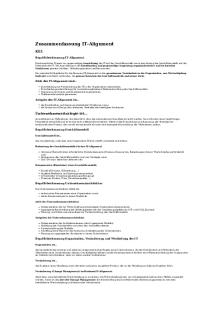Lecture notes - Approximating an optimal sum-of-pairs multiple alignment PDF

| Title | Lecture notes - Approximating an optimal sum-of-pairs multiple alignment |
|---|---|
| Course | Algorithms in Bioinformatics - Sequenses |
| Institution | Aarhus Universitet |
| Pages | 26 |
| File Size | 1.2 MB |
| File Type | |
| Total Downloads | 89 |
| Total Views | 135 |
Summary
Approximating an optimal Sum-of-Pairs multiple alignment...
Description
Approximating an optimal Sum-of-Pairs multiple alignment
Sum-of-Pairs Multiple Alignment Problem Let F be a set of k strings, each of length ≤ n, we know how to an optimal SP-alignment M* in time O(nk) using dynamic programming. We will show how to compute an alignment M in time O(k2n2) s.t.
Notation Let d(x,y) be a metric between characters Let D(S,S') be the induced metric between strings as given by the optimal score of a global pairwise alignment (with linear gap cost)
Alignments consistent with a tree M:
A A C A
T T -
T – -
C C C C
G – G G
G
T T A T
S1 S4
A - - C G - T
Score(M(S1,S4)) = Score( A - - C G G T ) ≥ D(S1, S4)
Alignments consistent with a tree M:
A A C A
T T -
T – -
C C C C
G – G G
G
T T A T
S1 S4
A - - C G - T
Score(M(S1,S4)) = Score( A - - C G G T ) ≥ D(S1, S4) Definition (Gusfield, p. 347): Let F be a set of strings, and let T be a tree where each node is labeled with a distinct string from F . Then, a multiple alignment M of F is called consistent with T if the induced pairwise alignment of Si and Sj has score D(Si,Sj) for each pair of strings (Si,Sj) that label adjacent nodes in T
The “guide” tree S3 S2 S1
s consistent with a tree
S4 M:
A A C A
T T -
T – -
C C C C
G – G G
G
T T A T
S1 S4
“=” if consistent with “guide tree”
A - - C G - T
Score(M(S1,S2)) = Score( A - - C G G T ) ≥ D(S1, S4) Definition (Gusfield, p. 347): Let F be a set of strings, and let T be a tree where each node is labeled with a distinct string from F . Then, a multiple alignment M of F is called consistent with T if the induced pairwise alignment of Si and Sj has score D(Si,Sj) for each pair of strings (Si,Sj) that label adjacent nodes in T
The “guide” tree S3 S2 S1
s consistent with a tree
S4 M:
A A C A
T T -
T – -
C C C C
G – G G
G
T T A T
S1 S4
“=” if consistent with “guide tree”
A - - C G - T
Score(M(S1,S2)) = Score( A - - C G G T ) ≥ D(S1, S4) Definition (Gusfield, p. 347): Let F be a set of strings, and let T be a tree where each node is labeled with a distinct string from F . Then, a multiple alignment M of F is called consistent with T if the induced pairwise alignment of Si and Sj has score D(Si,Sj) for each pair of strings (Si,Sj) that label adjacent nodes in T Lemma 14.6.1 (Gusfield, p. 347): For any set of strings F and for any tree T whose nodes are labeled by distinct strings of F, we can efficiently find a multiple alignment M(T) of F that is consistent with T
Algorithm Input: A set F of k strings, each of length ≤ n Step 1 – Find the “center” string Find S1 such that
is minimized.
Call the remaining strings S2, S3, ..., Sk
The “guide” tree S3 S2
Algorithm Input: A set F of k strings, each of
S1 Step 1 – Find the “center” s Find S1 such that
is minimized.
Call the remaining strings S2, S3, ..., Sk
S4
Algorithm
The “guide” tree S3 S2
Input: A set F of k strings, each of S1
S4
Step 1 – Find the “center” s Find S1 such that
is Takes time O(n2) for each of the k(k-1) pairs of strings Call the remaining strings S2, S3, ..., Sk
Algorithm
The “guide” tree S3 S2
Input: A set F of k strings, each of S1
S4
Step 1 – Find the “center” s Find S1 such that
is Takes time O(n2) for each of the k(k-1) pairs of strings Call the remaining strings S2, S3, ..., Sk
Step 2 – Construct alignment M cf. “guide tree” M1 = [S1] for i = 2 to k: A = optalign(S1, Si) Mi = “Mi-1 extended with A” M = Mk
Example Assume that i=4:
Algorithm
A - - C G T A T T C – T M3 = C T – C G A
The “guide” tree S3 S2
t F of k strings, each of S1
S4= A C G G T
S4
1 – Find the “center” s
A C G – T A = A C G G T
that
is Takes time O(n2) for each of the k(k-1) pairs of strings remaining strings S2, S3, ..., Sk
Extend M3 with A gives: A A C M4 = A
T T -
T – -
C C C C
G – G G
G
T T A T
Note that the new column does not affect Score(S1, Si) for i < 4
struct alignment M cf. “guide tree”
M1 = [S1] for i = 2 to k: A = optalign(S1, Si) Mi = “Mi-1 extended with A” M = Mk
Example Assume that i=4:
Algorithm
A - - C G T A T T C – T M3 = C T – C G A
The “guide” tree S3 S2
t F of k strings, each of S1
S4= A C G G T
S4
1 – Find the “center” s
A C G – T A = A C G G T
that
is Takes time O(n2) for each of the k(k-1) pairs of strings remaining strings S2, S3, ..., Sk
Extend M3 with A gives: A A C M4 = A
T T -
T – -
C C C C
G – G G
G
T T A T
Note that the new column does not affect Score(S1, Si) for i < 4
struct alignment M cf. “guide tree” Takes time O(kn2)
M1 = [S1] for i = 2 to k: A = optalign(S1, Si) Mi = “Mi-1 extended with A” M = Mk
Algorithm Input: A set F of k strings, each of length ≤ n Step 1 – Find the “center” string Find S1 such that
is minimized.
Call the remaining strings S2, S3, ..., Sk Step 2 – Construct alignment M cf. “guide tree” M1 = [S1] for i = 2 to k: A = optalign(S1, Si) Mi = “Mi-1 extended with A” M = Mk
Algorithm Input: A set F of k strings, each of length ≤ n Step 1 – Find the “center” string Find S1 such that
is minimized.
Call the remaining strings S2, S3, ..., Sk Running time: O(k2n2 + kn2) = O(k2n2) Step 2 – Construct alignment M cf. “guide tree” M1 = [S1] for i = 2 to k: A = optalign(S1, Si) Mi = “Mi-1 extended with A” M = Mk
Approximation Ratio, part 1 Finding an upper bound of the computed alignment M
The score of the alignment of Si and Sj as induced by M
Approximation Ratio, part 1 Finding an upper bound of the computed alignment M
The score of the alignment of Si and Sj as induced by M
Using the triangle-inequality and symmetry. Valid because the substitution matrix is metric
Approximation Ratio, part 1 Finding an upper bound of the computed alignment M
The score of the alignment of Si and Sj as induced by M
Using the triangle-inequality and symmetry. Valid because the substitution matrix is metric
Expanding and rewriting the sum
Approximation Ratio, part 1 Finding an upper bound of the computed alignment M
The score of the alignment of Si and Sj as induced by M
Using the triangle-inequality and symmetry. Valid because the substitution matrix is metric
Expanding and rewriting the sum
M is consistent with the guide tree, where S1 is the center
Expanding and rewriting ...
Approximation Ratio, part 2 Finding a lower bound of the score of an optimal alignment M*
The score of the alignment of Si and Sj as induced by M*
Approximation Ratio, part 2 Finding a lower bound of the score of an optimal alignment M*
The score of the alignment of Si and Sj as induced by M* Nothing is better than the optimal scores
Approximation Ratio, part 2 Finding a lower bound of the score of an optimal alignment M*
The score of the alignment of Si and Sj as induced by M* Nothing is better than th optimal scores
By choice of S1 we have Σj D(S1, Sj) ≤ Σj D(Si, Sj) for any i
Approximation Ratio, part 2 Finding a lower bound of the score of an optimal alignment M*
The score of the alignment of Si and Sj as induced by M* Nothing is better than th optimal scores
By choice of S1 we have Σj D(S1, Sj) ≤ Σj D(Si, Sj) for any i
Rewriting and renaming
Approximation Ratio, part 3 Upper-bound
Lower-bound
Using the upper- and lower-bounds we get
Approximation Ratio, part 3 Upper-bound
Lower-bound
Using the upper- and lower-bounds we get
Can we do better? SP-multiple alignment is NP-complete [Wang and Jiang 1994] PTAS by [Bafna, Lawler, Pevzner 1995] gives
in time O(k3 n2q-1), where 1≤q...
Similar Free PDFs

Chapter 2 Internal Alignment
- 26 Pages

IT-Alignment-Zusammenfassung
- 18 Pages

9 Incentive Alignment PDF
- 2 Pages

Ch7 Optimal Risky Portfolios
- 41 Pages
Popular Institutions
- Tinajero National High School - Annex
- Politeknik Caltex Riau
- Yokohama City University
- SGT University
- University of Al-Qadisiyah
- Divine Word College of Vigan
- Techniek College Rotterdam
- Universidade de Santiago
- Universiti Teknologi MARA Cawangan Johor Kampus Pasir Gudang
- Poltekkes Kemenkes Yogyakarta
- Baguio City National High School
- Colegio san marcos
- preparatoria uno
- Centro de Bachillerato Tecnológico Industrial y de Servicios No. 107
- Dalian Maritime University
- Quang Trung Secondary School
- Colegio Tecnológico en Informática
- Corporación Regional de Educación Superior
- Grupo CEDVA
- Dar Al Uloom University
- Centro de Estudios Preuniversitarios de la Universidad Nacional de Ingeniería
- 上智大学
- Aakash International School, Nuna Majara
- San Felipe Neri Catholic School
- Kang Chiao International School - New Taipei City
- Misamis Occidental National High School
- Institución Educativa Escuela Normal Juan Ladrilleros
- Kolehiyo ng Pantukan
- Batanes State College
- Instituto Continental
- Sekolah Menengah Kejuruan Kesehatan Kaltara (Tarakan)
- Colegio de La Inmaculada Concepcion - Cebu











